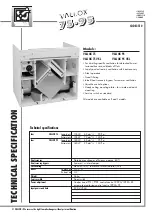
SHEVS Control Centre RWZ 1 b
8
3.8
Alarm and malfunction forwarding (option PK)
●
PFC
r
(PFC alarm): The contact will be activated upon detection of an alarm. After resetting the alarm, the
contact resets to its neutral position.
●
PFC
s
(PFC malfunction): The contact is activated when a malfunction is detected (see 5). After eliminating
the cause of malfunction, the contact resets to its neutral position.
i
The contacts are not enabled during alarm testing and maintenance mode.
4
Maintenance
●
In the course of maintenance - unless other local regulations apply - check all functions and indicators of the
Control Centre and its components at least once a year. This also includes the review of terminal points, con-
nection cables, indicators and fuses, as well as the cleaning of various components, if necessary. Check
mounting brackets, etc. for proper fitting. Lubricate actuators and SHE vents (domelights, flap ventilators, lou-
vred ventilators etc.), if necessary.
The individual functions of the Control Centre are described in section 3. Likewise, simulate malfunctions of
the signal lines and power supply and check detection; see 5.
●
Display of due maintenance
If this function has been enabled by the maintenance company, the Control Centre indicates the due mainte-
nance through flashing of indicator
9
after about 11 months of operating time. After about 14 months mainte-
nance is overdue and a malfunction signal is generated additionally.
●
Accumulators:
−
Check the accumulators
at least once
a year for proper functioning. They should be replaced following a
typical service life of 3, but no more than 4 years in an ambient temperature of 20
°C. The service life falls
by 1 year for every 10
°C rise in ambient temperature!
−
Checking the accumulators: Press the button
Test
r
in the Control Centre and then briefly press the but-
ton
Reset
S
. This switches from mains to accumulator operation during the alarm test (actuators travel a
bit slower). Open the actuators completely. If the accumulator voltage falls below 22.5
V, a malfunction is
indicated. This indication continues until the button
Reset
S
is briefly pressed.
After testing the accumulators, reset the alarm testing (press button
Reset
r
briefly) and close all actua-
tors again.
i
A quick check of the accumulators with less load takes place automatically every 15 minutes.
−
The end user, i.e. the final owner, must return used batteries / accumulators to a distributor or public
waste management authority. This obligation to return applies regardless of whether it is a private or
commercial end user.
−
If the system is put out of service / temporarily shut down,
the accumulators must be unplugged
and
the line voltage switched off!
−
Charged accumulators that are not connected yet have a shelf-life of about 6 months. For longer storage,
they must be recharged.
!
When directly driving actuators
, e.g. with external accumulators during installation or maintenance work,
the actuators must be disconnected from the Control Centre
! Otherwise, this can lead to defects in the
power output of the Control Centre.
●
Systems with internal wind and rain module (option WRM):
Following inspections / work should be performed at least once a year:
−
Cleaning the rain sensor with a damp cloth, possibly with a mild detergent.
Do not scour the sensor surface!
−
Check the wind sensor for smooth-running
−
Functional testing of the sensors
−
Check whether the SHE units and / or ventilation devices are properly closed







































